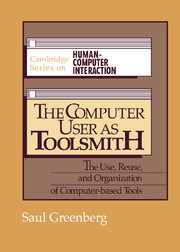Book contents
- Frontmatter
- Contents
- List of figures
- List of tables
- Foreword
- Acknowledgments and dedication
- 1 Introduction
- 2 Studying UNIX
- 3 Using commands in UNIX
- 4 Techniques for reusing activities
- 5 Recurrent systems
- 6 Reuse opportunities in UNIX csh – potential and actual
- 7 Principles, corroboration, and justification
- 8 Organizing activities through workspaces
- 9 A workspace system: description and issues
- 10 Conclusion
- Appendix A A sample trace
- Appendix B Summary statistics for each subject
- References
- Author index
- Subject index
6 - Reuse opportunities in UNIX csh – potential and actual
Published online by Cambridge University Press: 26 May 2010
- Frontmatter
- Contents
- List of figures
- List of tables
- Foreword
- Acknowledgments and dedication
- 1 Introduction
- 2 Studying UNIX
- 3 Using commands in UNIX
- 4 Techniques for reusing activities
- 5 Recurrent systems
- 6 Reuse opportunities in UNIX csh – potential and actual
- 7 Principles, corroboration, and justification
- 8 Organizing activities through workspaces
- 9 A workspace system: description and issues
- 10 Conclusion
- Appendix A A sample trace
- Appendix B Summary statistics for each subject
- References
- Author index
- Subject index
Summary
In this chapter, I consider the potential and actual reuse opportunities within UNIX. First, several methods are suggested that could increase the likelihood that the next submission matches an item in a small set of predictions offered to the user for review and reuse. All methods are applied to the UNIX traces, and the predictive “quality” of each method is measured and contrasted against the others. In the second part of the chapter, I investigate how well the reuse facilities supplied by the UNIX shell are used in practice.
Conditioning the distribution
In the last chapter, particular attention was paid to the recurrence of command lines during csh use, and to the probability distribution of the next line given a sequential history list of previous ones. We saw that the most striking feature of the collected statistics is the tremendous potential for a historical reuse facility: the recurrence rate is high and the last few submissions are the likeliest to be repeated.
One may predict what the user will do next by looking at those recent submissions. But there is still room for improvement, because a significant portion of recurrences are not recent submissions. Can better predictions of the user's next step be offered? This section proposes and evaluates alternative models of arranging a user's command line history that will condition the distribution in different ways.
The recurrence distributions of Section 5.4.2 were derived by considering all input for a user as one long sequential stream, with no barriers placed between sessions.
- Type
- Chapter
- Information
- The Computer User as ToolsmithThe Use, Reuse and Organization of Computer-Based Tools, pp. 84 - 107Publisher: Cambridge University PressPrint publication year: 1993

